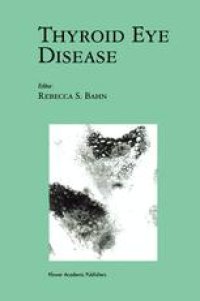
Ebook: Thyroid Eye Disease
Author: Anthony P. Weetman E. Helen Kemp Jonathan N. Ridgway Philip F. Watson (auth.) Rebecca S. Bahn (eds.)
- Tags: Diabetes, Immunology, Ophthalmology
- Series: Endocrine Updates 14
- Year: 2001
- Publisher: Springer US
- Edition: 1
- Language: English
- pdf
Patients aftlicted with thyroid eye disease or Graves' ophthamopathy (GO) may experience not only pain and visual loss, but also disfigurement. Full understanding of pathogenesis has been elusive, and treatment modalities are imperfect. As with other conditions, more effective intervention will follow only after a better understanding of pathogenesis is reached. The goal of this volume is to give an overview by leaders in the field of the present state of the art both in pathogenesis and clinical aspects of GO. Much attention has been directed towards determining which cells within the orbit are targets of the autoimmune process, and how these and other cells might participate in the local inflammatory process. It is now generally agreed that orbital fibroblasts, preadipocyte fibroblasts, and adipocytes are the targeted and activated cells in GO and that full-length TSH receptor (TSHr) is expressed in these cells. Further, there is growing consensus that this receptor is up-regulated in the orbit in GO, residing primarily in newly differentiated adipocytes. However, it is also evident, given a sufficiently sensitive assay, that TSHr is detectable in fibroblasts and adipocytes from the normal orbit and other anatomic sites, as well. It will be important to determine whether the observed increase in orbital TSHr expression itself initiates the orbital autoimmune process. Also to be decided is whether orbital lymphocytes from GO patients specifically recognize this receptor, and what factor or factors unique to Graves' dIsease might stimulate TSHr expression in orbital cells.